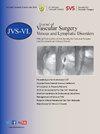Social disparities in pulmonary embolism and deep vein thrombosis during the coronavirus disease 2019 pandemic from the Nationwide inpatient Sample
IF 2.8
2区 医学
Q2 PERIPHERAL VASCULAR DISEASE
Journal of vascular surgery. Venous and lymphatic disorders
Pub Date : 2025-01-01
DOI:10.1016/j.jvsv.2024.101961
引用次数: 0
Abstract
Objectives
Studies have shown that coronavirus disease 2019 (COVID-19) is associated with a hypercoagulable state. Studies have yet to examine the interconnectedness between COVID-19, hypercoagulability, and socioeconomics. The aim of this work was to investigate socioeconomic factors that may be associated with pulmonary embolism (PE), deep vein thrombosis (DVT), and COVID-19 in the United States.
Methods
We performed a 1-year (2020) analysis of the National Inpatient Sample database. We identified all adult patients diagnosed with COVID-19, acute PE, or acute DVT using unweighted samples. We calculated the correlation and odds ratio (OR) between COVID-19 and (1) PE and (2) DVT. We executed a univariate analysis followed by a multivariate analysis to examine the effect of different factors on PE and DVT during the COVID-19 pandemic.
Results
We identified 322,319 patients with COVID-19; 78,101 and 67,826 patients were identified with PE and DVT, respectively. PE and DVT, as well as inpatient mortality associated with both conditions, are significantly correlated with COVID-19. The OR between COVID-19 and PE was 2.04, while the OR between COVID-19 and DVT was 1.44. Using multivariate analysis, COVID-19 was associated with a higher incidence of PE (coefficient, 2.05) and DVT (coefficient, 1.42). Other factors that were significantly associated (P < .001) with increased incidence of PE and DVT along with their coefficients, respectively, include Black race (95% confidence interval [CI], 1.23-1.14), top quartile income (95% CI, 1.08-1.16), west region (95% CI, 1.10-1.04), urban teaching facilities (95% CI, 1.09-1.63), large bed size hospitals (95% CI, 1.08-1.29), insufficient insurance (95% CI, 1.88-2.19), hypertension (95% CI, 1.24-1.32), and obesity (95% CI, 1.41-1.25). Factors that were significantly associated (P < .001) with decreased incidence of PE and DVT along with their coefficients, respectively, include Asians/Pacific Islanders (95% CI, 0.52-0.53), female sex (95% CI, 0.79-0.74), homelessness (95% CI, 0.62-0.61), and diabetes mellitus (0.77-0.90).
Conclusions
In the Nationwide Inpatient Sample, COVID-19 is correlated positively with venous thromboembolism, including its subtypes, PE and DVT. Using a multivariate analysis, Black race, male sex, top quartile income, west region, urban teaching facilities, large bed size hospitals, and insufficient social insurance were associated significantly with an increased incidence of PE and DVT. Asians/Pacific Islanders, female sex, homelessness, and diabetes mellitus were significantly associated decreased incidence of PE and DVT.
从全国住院病人样本看 COVID-19 大流行期间肺栓塞和深静脉血栓形成的社会差异(2020 年)。
导言/目标:研究表明,冠状病毒病 2019(COVID-19)与高凝状态有关。目前尚未有研究探讨 COVID-19、高凝状态和社会经济之间的相互联系。本研究旨在调查美国可能与肺栓塞(PE)、深静脉血栓(DVT)和 COVID-19 相关的社会经济因素:我们对全国住院病人抽样数据库进行了为期一年(2020 年)的分析。我们使用非加权样本确定了所有确诊为 COVID-19、急性 PE 或急性深静脉血栓的成年患者。我们计算了 COVID-19 与 1) PE 和 2) 深静脉血栓之间的相关性和几率比 (OR)。我们进行了单变量分析和多变量分析,以研究 COVID-19 大流行期间不同因素对 PE 和深静脉血栓的影响:结果:322 319 名患者被确认为 COVID-19 患者,78 101 名患者被确认为 PE 患者,67 826 名患者被确认为深静脉血栓患者。PE 和深静脉血栓以及与这两种疾病相关的住院病人死亡率与 COVID-19 显著相关。COVID-19 与 PE 之间的 OR 值为 2.04,而 COVID-19 与 DVT 之间的 OR 值为 1.44。通过多变量分析,COVID-19 与 PE(系数 2.05)和 DVT(系数 1.42)的发病率较高相关。其他因素也有明显相关性(p结论:在美国全国住院病人样本中,COVID-19 与静脉血栓栓塞(包括其亚型:肺栓塞和深静脉血栓)呈正相关。通过多变量分析,黑人种族、男性性别、收入前四分之一、西部地区、城市教学设施、大床位规模医院和社会保险不足与 PE 和深静脉血栓的发病率增加显著相关。而亚洲人/太平洋岛民、女性、无家可归者和糖尿病则与 PE 和 DVT 发病率的降低有明显相关性。
本文章由计算机程序翻译,如有差异,请以英文原文为准。
求助全文
约1分钟内获得全文
求助全文
来源期刊

Journal of vascular surgery. Venous and lymphatic disorders
SURGERYPERIPHERAL VASCULAR DISEASE&n-PERIPHERAL VASCULAR DISEASE
CiteScore
6.30
自引率
18.80%
发文量
328
审稿时长
71 days
期刊介绍:
Journal of Vascular Surgery: Venous and Lymphatic Disorders is one of a series of specialist journals launched by the Journal of Vascular Surgery. It aims to be the premier international Journal of medical, endovascular and surgical management of venous and lymphatic disorders. It publishes high quality clinical, research, case reports, techniques, and practice manuscripts related to all aspects of venous and lymphatic disorders, including malformations and wound care, with an emphasis on the practicing clinician. The journal seeks to provide novel and timely information to vascular surgeons, interventionalists, phlebologists, wound care specialists, and allied health professionals who treat patients presenting with vascular and lymphatic disorders. As the official publication of The Society for Vascular Surgery and the American Venous Forum, the Journal will publish, after peer review, selected papers presented at the annual meeting of these organizations and affiliated vascular societies, as well as original articles from members and non-members.
 求助内容:
求助内容: 应助结果提醒方式:
应助结果提醒方式:


